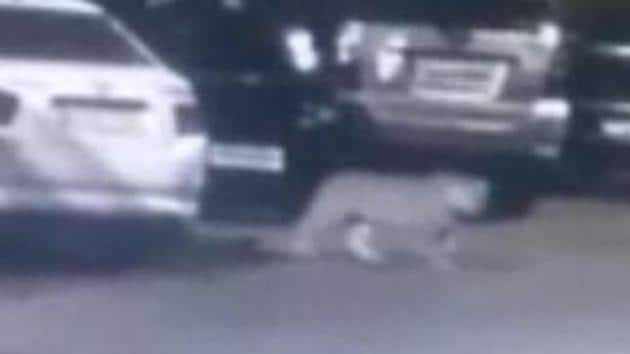Cameras will track two leopards spotted at Mulund complex
Thane forest range officials said the camera traps will help them understand what route the leopards take and how many visited the area
Following leopard sightings at a residential complex in Mulund (West), forest officers have set up six camera traps to track the animals.

The first sighting was on January 22, when a CCTV camera filmed a leopard in the area. On February 1, CCTV camera footage from a residential complex near Sardar Singh Pratap Singh Udyan, Mulund (West) — a garden adjoining Sanjay Gandhi National Park (SGNP) — showed a sub-adult leopard crossing a road at 1.15 am, followed by a much younger leopard a minute later.
Officials from the Mumbai forest range said the camera traps were placed in and around the garden. “Our patrolling team observed that the leopards entered the area from this garden. We directed a patrol team to be on standby at night as well,” said Santosh Kank, range forest officer, Mumbai. “We asked the civic body to install focus lights at the garden. We conduct regular awareness sessions with residents so there is no need for panic.”
Thane forest range officials said the camera traps will help them understand what route the leopards take and how many visited the area.
“These measures will ensure residents’ safety,” said Sunil Limaye, chief conservator of forests, Thane. “There is neither a threat to residents nor potential for man-animal conflict to occur. There is thus no need to trap the leopard. Residents must only be vigilant,” he said.
Residents said panic ensued after the recent CCTV camera footage was circulated. “Residents from different housing societies made regular visits to the Mumbai and Thane forest offices to report the leopard’s movements. Parents were scared to let their children play outside the complex after sunset,” said Prabhakar Natarajan, resident of Mount Classic II apartments, near Yogi Hills.
“Residents held internal meetings to discuss raising the height of the fence around complexes closer to Sanjay Gandhi National Park (SGNP). If the leopard’s visits become frequent, then the residents will request the forest department to trap it,” said Vaibhav Waghmode, resident of a Silver Oaks society in Mulund. “Residents driving through his area at night need to be careful.”
Members of Resqink Association for Wildlife Welfare (RAWW) — a non-government organisation — had deployed 10 volunteers in the area to help sensitise security guards and residents. “We spotted two different leopards but it is unclear whether they are mother and cub. We asked residents not to pressure the forest department to trap the animal,” said Pawan Sharma, president, RAWW.
Experts said the animals were trying to hunt for rats, dogs or other smaller animals.
“There is a slum close to the residential complex where these leopards hunt. They do not pose a threat to residents. However, the forest department needs to tell slum dwellers to avoid defecating in the open, as this can lead to a man-animal conflict at night,” said Krishna Tiwari, founder, forest and wildlife conservation society.
What are camera traps?
These cameras have heat and motion sensors, which detect movement and automatically take photos. They are usually set at knee level – strapped on trees, the ground or poles – and have a range of 20 to 30 feet.
Recent cases
In December, a free-roaming male leopard was trapped at Mathai Pada, near unit 25, Aarey Milk Colony, Goregaon by the Mumbai forest range. The move left wildlife activists furious. It was the second leopard-trapping incident in two months.
In November, the forest department caught an eight-year-old male leopard in Hiranandani, Powai. It was then shifted to Sanjay Gandhi National Park (SGNP). After a medical examination was conducted, the leopard was released in its natural habitat.
Read
Four-legged pedestrian on the road: CCTV captures leopard in Mumbai street



